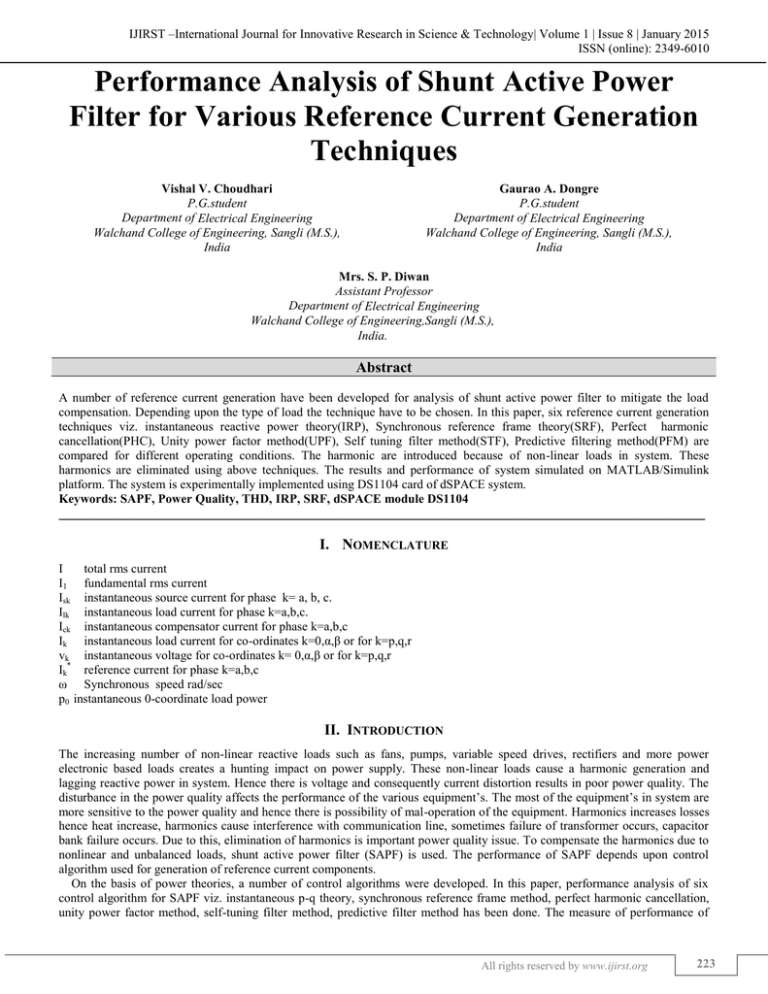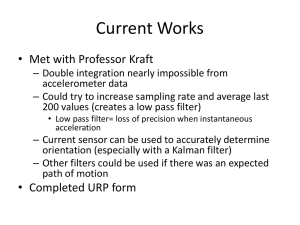
IJIRST –International Journal for Innovative Research in Science & Technology| Volume 1 | Issue 8 | January 2015
ISSN (online): 2349-6010
Performance Analysis of Shunt Active Power
Filter for Various Reference Current Generation
Techniques
Vishal V. Choudhari
P.G.student
Department of Electrical Engineering
Walchand College of Engineering, Sangli (M.S.),
India
Gaurao A. Dongre
P.G.student
Department of Electrical Engineering
Walchand College of Engineering, Sangli (M.S.),
India
Mrs. S. P. Diwan
Assistant Professor
Department of Electrical Engineering
Walchand College of Engineering,Sangli (M.S.),
India.
Abstract
A number of reference current generation have been developed for analysis of shunt active power filter to mitigate the load
compensation. Depending upon the type of load the technique have to be chosen. In this paper, six reference current generation
techniques viz. instantaneous reactive power theory(IRP), Synchronous reference frame theory(SRF), Perfect harmonic
cancellation(PHC), Unity power factor method(UPF), Self tuning filter method(STF), Predictive filtering method(PFM) are
compared for different operating conditions. The harmonic are introduced because of non-linear loads in system. These
harmonics are eliminated using above techniques. The results and performance of system simulated on MATLAB/Simulink
platform. The system is experimentally implemented using DS1104 card of dSPACE system.
Keywords: SAPF, Power Quality, THD, IRP, SRF, dSPACE module DS1104
_______________________________________________________________________________________________________
I. NOMENCLATURE
I
total rms current
I1 fundamental rms current
Isk instantaneous source current for phase k= a, b, c.
Ilk instantaneous load current for phase k=a,b,c.
Ick instantaneous compensator current for phase k=a,b,c
Ik instantaneous load current for co-ordinates k=0,α,β or for k=p,q,r
vk instantaneous voltage for co-ordinates k= 0,α,β or for k=p,q,r
Ik* reference current for phase k=a,b,c
ω Synchronous speed rad/sec
p0 instantaneous 0-coordinate load power
II. INTRODUCTION
The increasing number of non-linear reactive loads such as fans, pumps, variable speed drives, rectifiers and more power
electronic based loads creates a hunting impact on power supply. These non-linear loads cause a harmonic generation and
lagging reactive power in system. Hence there is voltage and consequently current distortion results in poor power quality. The
disturbance in the power quality affects the performance of the various equipment’s. The most of the equipment’s in system are
more sensitive to the power quality and hence there is possibility of mal-operation of the equipment. Harmonics increases losses
hence heat increase, harmonics cause interference with communication line, sometimes failure of transformer occurs, capacitor
bank failure occurs. Due to this, elimination of harmonics is important power quality issue. To compensate the harmonics due to
nonlinear and unbalanced loads, shunt active power filter (SAPF) is used. The performance of SAPF depends upon control
algorithm used for generation of reference current components.
On the basis of power theories, a number of control algorithms were developed. In this paper, performance analysis of six
control algorithm for SAPF viz. instantaneous p-q theory, synchronous reference frame method, perfect harmonic cancellation,
unity power factor method, self-tuning filter method, predictive filter method has been done. The measure of performance of
All rights reserved by www.ijirst.org
223
Performance Analysis of Shunt Active Power Filter for Various Reference Current Generation Techniques
(IJIRST/ Volume 1 / Issue 8 / 039)
algorithms are source current total harmonic distortion (THD), total distortion content (TDC), magnitude of neutral current. The
results obtained shows that under normal operating condition all algorithms are suitable for compensation.
Rest of the paper is organized as follows: In section III, brief discussion on different control algorithms compared is presented.
In section IV, simulation results are described. Finally, in section V, conclusions are drawn.
III. CONTROL ALGORITHMS
A. Instantaneous p-q Theory
The voltages and currents from a-b-c frame are transformed into 0-α-β frame by using Clark’s transformation as
[
√
]
[
√
√
√
[ ]
√
√
[
]
(1)
√
√
√
] [
√
√
] [ ]
(2)
√
Instantaneous three phase real and imaginary power respectively are given by
(
(
)
)
(
(
)
)
(
)
(3)
(4)
From (1), (2) and (3)
[ ]
[
] [ ]
(5)
From this real and reactive power, the reference current for 0-α-β frame is given as
[ ]
[
] [ ]
(6)
Thus the compensator current can derived as
√
√ [
[ ]
√
√ ] [ ]
√
√
(7)
B. Synchronous Reference Frame Theory
This method is also known as d-q or Id–Iq method. It is based on Reference Frame transformation i.e. the transformation of
coordinates from a three-phase a-b-c stationery co-ordinate system to the 0-d- q rotating coordinate system. It is done using
following equations
[ ]
√ [
√
√
][
]
(1)
(
)
(
)
][ ]
(2)
(
)
(
)
The output of this equation contains AC component or oscillating value as well as DC component or average value. To
eliminate the AC component which contain harmonic component, low pass filter is used. So that DC component which is output
of above equation is harmonic free.
̅ ̃
[ ] [
]
(3)
̅ ̃
Now this harmonic free signal in 0-d-q rotating frame is converted back into a -b-c stationery frame as shown below.
[ ]
[
[ ]
[
(
(
)
)
(
(
)
)
]
[ ]
(4)
And
√
[ ]
√
[ ]
[
√
(5)
]
All rights reserved by www.ijirst.org
224
Performance Analysis of Shunt Active Power Filter for Various Reference Current Generation Techniques
(IJIRST/ Volume 1 / Issue 8 / 039)
These reference currents are used for the generation of the PWM pulses by using the HCC i.e. hysteresis current controller .
C. Perfect Harmonic cancellation
The objective of PHC is to compensate all the harmonic currents and the fundamental reactive power demanded by the load in
addition to eliminating the imbalance. Assume the voltages at the point of common coupling PCC are V a, Vb, Vc, and loading
currents are ILa, ILb, ILc,
The instantaneous power of the load is given by,
(1)
It contains mean and oscillating values
̃
̅
(2)
The reference source current is given by:
(3)
Where v+1 is the PCC voltage space vector with a single fundamental positive sequence component obtained from the phaselocked loop (PLL) circuit.
The power delivered by the source will be:
(
) (4)
The average (mean) power is calculated by using low pass filter (LPF).
The value of K parameter in the above equation is calculated by taking division of average load power and summation of the
squared of the positive sequence component of the PCC voltages.
̅
(5)
Once the parameter K is obtained, the source reference currents are calculated by multiplying it by the positive sequence
component of the voltage
[
]
[
̅
]
[
]
(6)
The actual reference currents are calculated by taking inverse transformation of the above equation.
D. Unity Power Factor Method
This method is also known as voltage synchronization method. Because the current source waveform is in phase with voltage
source waveform at the PCC will have identical wave shape with different amplitudes.
The reference source current is calculated from following equation
(1)
Where K is constant which value depends upon the source voltage and load current.
The power delivered by source
(
)
(2)
Then the compensator current
(3)
(4)
The conductance K can be finding by considering that the power delivered by the source equals the dc component of the
instantaneous active power of the load
̅
̅
(
(5)
)
Finally the reference source current are calculated as
[
]
[
]
̅
(
̅
)
[ ]
(6)
These currents are in the form of 0-α-β, to get actual reference currents it is necessary to take inverse transformation of above
equation.
E. Self Tuning Filter
It is a modified version of classical p-q theory. Basically this theory is useful for distorted supply voltage. The STF is used to
extract the fundamental component directly from electrical signals. The load current are transformed into 0-α-β frame as
All rights reserved by www.ijirst.org
225
Performance Analysis of Shunt Active Power Filter for Various Reference Current Generation Techniques
(IJIRST/ Volume 1 / Issue 8 / 039)
[ ]
√
[
√
√
√
√
] [ ]
(1)
√
Similarly the real and reactive power are calculated as
(
(
)
)
(
(
)
)
(
)
(2)
(3)
This equation can be written as
[ ]
[
] [ ]
(4)
The reference current is calculated as
̃
̃
̅̅̅̅
̅
(5)
̅
̅̅̅̅
̅
(6)
̅
By using these equations the compensation current is calculated as
[ ]
√ [
√
√
√
√ ] [ ]
√
(7)
F. Predective Filtering Method
As like above techniques the predictive filtering method is also used for the reference current generation and harmonic
compensation. The load current is converted to digital signal and filtered with low pass filter. At the output of low pass filter, the
fundamental harmonic component is obtained. Hence the reference current is obtained by subtracting the fundamental harmonic
component from the load current. As the reference current generated is digital hence it is converted to analog signal.
IV. SIMULATION RESULTS AND ANALYSIS
To assess the performance of different control algorithm, simulations are designed and implemented in MATLAB. In MATLAB
simulation phase to phase source voltage is 400 volts, frequency 50Hz along with along with control techniques, non-linear load
and gate pulse generation. Various waveforms for different algorithms are shown below.
First fig. shows the source current waveform when SAPF is not connected and second fig. shows source current waveform
when SAPF is connected.
All rights reserved by www.ijirst.org
226
Performance Analysis of Shunt Active Power Filter for Various Reference Current Generation Techniques
(IJIRST/ Volume 1 / Issue 8 / 039)
Fig. 1: Source Current without SAPF
Fig. 2: Source Current When SAPF Is Connected
Following table shows the THD before compensation and after compensation
Sr.
no.
Theory
Before compensation
In %
After compensation
In %
1
IRP
25.01
4.41
2
SRF
25.01
4.83
3
PHC
25.01
2.39
4
UPF
25.01
5.92
5
STF
25.01
4.65
6
PFM
25.01
5.56
V. CONCLUSION
To overcome the problem of harmonics, comparative analysis of six control algorithms of shunt active power filter is done in this
paper. The harmonics generated in the system gets compensated by using these compensation techniques. The results shows that,
from all the six algorithms the perfect harmonic compensation method is most efficient in comparison with all.
REFERENCES
[1]
[2]
[3]
Kummari, N.K.; Singh, AK.; Kumar, P., "Comparative evaluation of DSTATCOM control algorithms for load compensation," Harmonics and Quality of
Power (ICHQP), 2012 IEEE 15th International Conference on , vol., no., pp.299,306, 17-20 June 2012.
Singh, B.; Solanki, J., "A Comparison of Control Algorithms for DSTATCOM," Industrial Electronics, IEEE Transactions on , vol.56, no.7, pp.2738,2745,
July 2009.
Czarnecki, Leszek S., "Instantaneous reactive power p-q theory and power properties of three-phase systems," Power Delivery, IEEE Transactions on ,
vol.21, no.1, pp.362,367, Jan. 2006.
All rights reserved by www.ijirst.org
227
Performance Analysis of Shunt Active Power Filter for Various Reference Current Generation Techniques
(IJIRST/ Volume 1 / Issue 8 / 039)
[4]
[5]
[6]
[7]
[8]
Waware, M.; Agarwal, P., "Use of multilevel inverter for elimination of harmonics in high voltage systems," Computer and Automation Engineering
(ICCAE), 2010 The 2nd International Conference on , vol.2, no., pp.311,315, 26-28 Feb. 2010.
Prof. S. P. Diwan, Vikas S. Bhandare, Nilesh M. Chamat, Snehal Jamadade,” Instantaneous Reactive Power Theory for Real Time Control of Three-Phase
Shunt Active Power Filter (SAPF)”International Conference on Circuit, Power and Computing Technologies [ICCPCT]2014.
Prof. S. P. Diwan, Vikas S. Bhandare, Nilesh M. Chamat, ”Control of Shunt Active Power Filter with PHC and SRF Methods for Compenasation of Source
Current Harmonics” International Journal of Engineering Research & Technology (IJERT) Vol. 3 Issue 5, May – 2014.
María Isabel Milanés Montero,Enrique Romero Cadaval, and Fermín Barrero González,” Comparison of Control Strategies for Shunt Active Power Filters
in Three-Phase Four-Wire Systems” IEEE TRANSACTIONS ON POWER ELECTRONICS, VOL. 22, NO. 1, JANUARY 200.7
Viji, AJ.; Pushpalatha, R.; Rekha, M., "Comparison of a active harmonic compensator with PWM and delta modulation under distorted voltage conditions,"
Recent Advancements in Electrical, Electronics and Control Engineering (ICONRAEeCE), 2011 International Conference on , vol., no., pp.82,86, 15-17
Dec. 2011.
All rights reserved by www.ijirst.org
228








